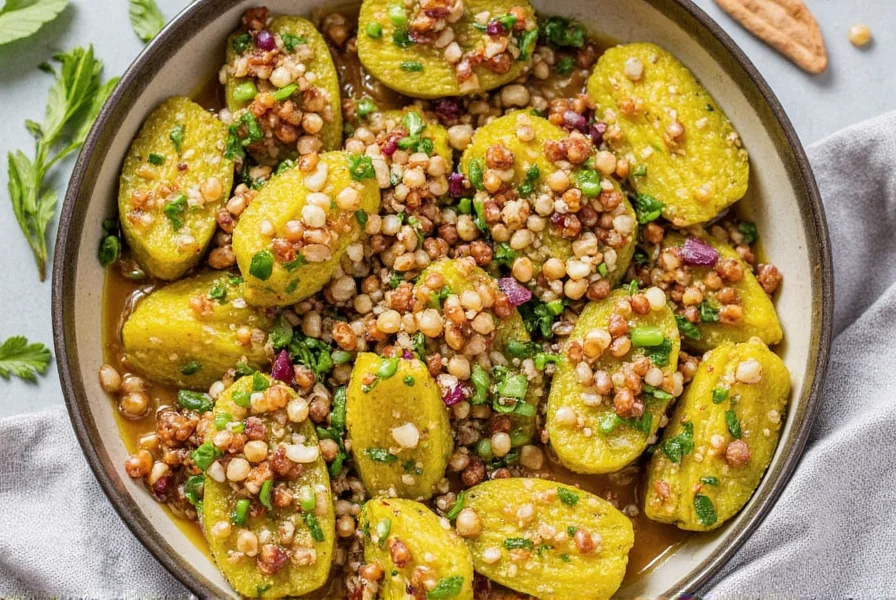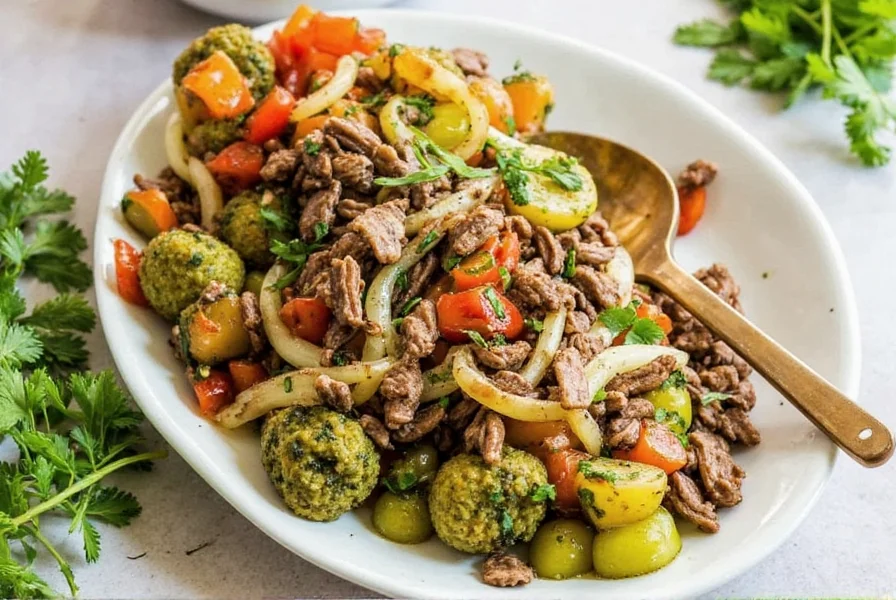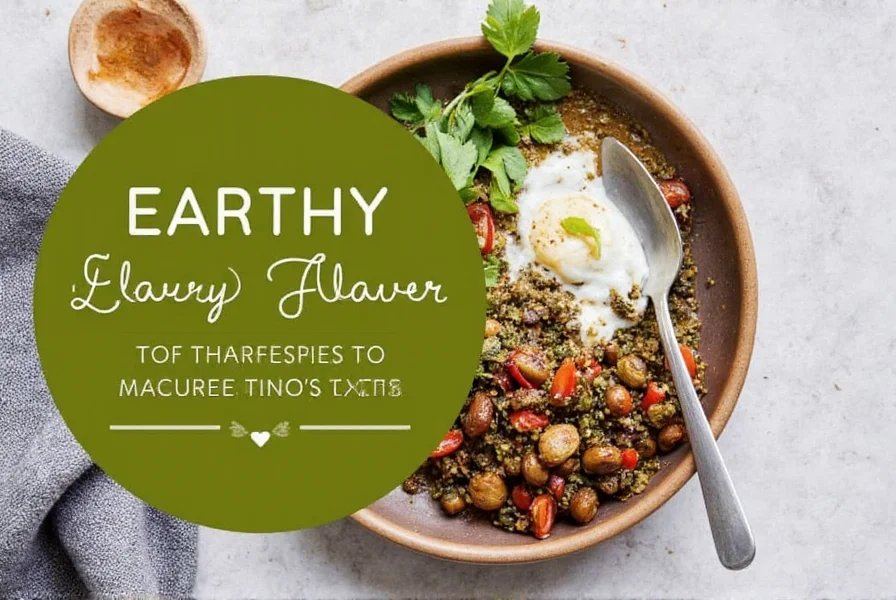Earthy flavor is a taste and aroma profile in food that evokes soil, roots, and natural elements. It's caused by compounds like geosmin, produced by soil bacteria, which gives foods like mushrooms and beets their distinctive deep, grounding notes. This guide explains what earthy flavor is, which ingredients contain it, how to pair and cook with it, and answers common questions.
Table of Contents
- What Exactly Is Earthy Flavor?
- Top 5 Spices That Bring Out an Earthy Flavor
- How to Pair Earthy Flavors with Other Tastes
- Cooking Tips: Bringing Out the Best in Earthy Ingredients
- Buying Guide: Choosing the Right Earthy Spices and Ingredients
- Frequently Asked Questions About Earthy Flavor
- Conclusion: Make the Earth Move on Your Plate
What Exactly Is Earthy Flavor?
Earthiness in food comes from naturally occurring organic compounds like geosmin, which is produced by certain bacteria in the soil and is responsible for that fresh smell after rain (petrichor). When we talk about earthy flavors, we're referring to ingredients like:
- Mushrooms
- Beets
- Parsnips
- Cumin
- Coriander seeds
These foods have a deep, rooty, almost woody flavor that grounds a dish and gives it depth.

Top 5 Spices That Bring Out an Earthy Flavor
Spices are where the magic happens when you're cooking with earthy tones. Here's a quick list of must-have spices that add complexity and depth to any meal:
| Spice | Flavor Profile | Best Used In |
|---|---|---|
| Cumin | Smoky, warm, slightly bitter | Curries, chili, stews |
| Coriander Seeds | Woody, citrusy undertone | Rubs, pickles, soups |
| Paprika | Sweet, smoky, rich | Stews, rice dishes, grilled meat |
| Turmeric | Earthy, peppery, mildly bitter | Rice, sauces, curries |
| Sumac | Zesty, lemony with earthy depth | Dry rubs, salads, dips |

Pro Tip: Toasting whole spices like cumin or coriander seeds before grinding them unlocks their full aroma and enhances the earthy depth in your dishes. A quick 30-second dry roast in a pan can make all the difference!
How to Pair Earthy Flavors with Other Tastes
One of the most fun parts of working with earthy flavors is experimenting with pairings. Think of earthy notes like the bass line in a song—they're not always the star, but they give everything else structure. Here's how to mix and match for maximum flavor impact:

- With Sweetness: Root vegetables like carrots or parsnips pair beautifully with honey or maple syrup. Try roasting parsnips with olive oil, sumac, and a drizzle of honey for a sweet-earthy combo.
- With Acid: Lemon juice or vinegar cuts through heavy earthiness and brightens up dishes. A squeeze of lemon over sautéed mushrooms adds balance.
- With Heat: Spicy chilies bring warmth and contrast. Try adding a pinch of crushed red pepper to your lentil soup for extra kick.
- With Salt: Salty cheeses like feta or Parmesan enhance earthy notes in vegetable-based dishes. Sprinkle some Parmesan over roasted beets and watch the magic happen.
- With Umami: Mushrooms, soy sauce, and miso play well together. A mushroom-miso broth is a flavor bomb of umami and earthiness.
Cooking Tips: Bringing Out the Best in Earthy Ingredients
Cooking with earthy ingredients requires a little finesse. Too much, and your dish becomes muddy; too little, and you lose the depth. Here are five pro tips to get it just right:
- Don't Overcook: Vegetables like beets or mushrooms become more intense the longer they cook. Roast until tender but not mushy.
- Use Fat: Fats like olive oil, butter, or ghee help carry earthy flavors throughout a dish. Sauté spices in oil first for better distribution.
- Balance with Fresh Herbs: Parsley, thyme, or rosemary lighten up earthy dishes and prevent them from feeling too heavy.
- Toasting Before Grinding: As mentioned earlier, toasting spices like cumin or coriander intensifies their natural oils and earthy aroma.
- Layer Flavors: Start with toasted spices, build with aromatics (onions, garlic), add your earthy base (like lentils or mushrooms), and finish with acid or herb brightness.

Buying Guide: Choosing the Right Earthy Spices and Ingredients
When shopping for earthy spices and ingredients, quality matters. Here's how to choose the best ones and what to look out for:
| Item | Features | Advantages | Use Cases | Target Audience |
|---|---|---|---|---|
| Cumin Seeds | Fragrant, dark brown, uniform size | Long shelf life, easy to toast | Chili, curries, tacos | Home cooks, spice lovers |
| Ground Cumin | Strong aroma, fine texture | Instant flavor boost | Quick meals, soups | Beginners, time-crunched cooks |
| Coriander Seeds | Brownish-yellow, lightly fragrant | Versatile, pairs with many cuisines | Rubs, pickles, curries | Culinarians, gourmet cooks |
| Mushrooms (Shiitake, Porcini) | Dense caps, no sliminess | Rich umami and earthy flavor | Risottos, stir-fries, broths | Chefs, gourmet home cooks |
| Beets (fresh or vacuum-sealed) | Firm, vibrant skin, no soft spots | Natural sweetness, bold color | Salads, roasts, juices | Health-conscious eaters, foodies |

Pro Shopping Tip: If you buy whole spices, store them in airtight containers away from light. Whole spices last longer than ground versions and retain their potency for months. Ground spices should be replaced every 6–12 months for optimal flavor.
Frequently Asked Questions About Earthy Flavor
What exactly is earthy flavor in food?
Earthy flavor refers to taste and aroma profiles reminiscent of soil, roots, forests, and damp earth. It's not about literally tasting dirt, but rather experiencing complex compounds like geosmin (produced by soil bacteria) that create that distinctive grounded, woody sensation we associate with certain foods.
Which foods naturally have earthy flavor?
Common earthy-flavored foods include mushrooms (especially porcini and shiitake), beets, parsnips, sweet potatoes, black truffles, and certain meats like game. Many spices also carry earthy notes, including cumin, turmeric, and coriander seeds.
Are earthy flavors healthy?
Yes! Many earthy ingredients are nutritional powerhouses. Beets are rich in nitrates that support cardiovascular health, turmeric contains curcumin (a potent anti-inflammatory), and cumin is packed with iron and antioxidants. Earthy foods often contain beneficial phytochemicals and fiber.
How can I tone down earthy flavors if they're too strong?
To balance overly earthy dishes, try adding acidity (lemon juice or vinegar), sweetness (honey or maple syrup), salt (like feta cheese), or fresh herbs (parsley or cilantro). Roasting earthy vegetables with citrus zest can also brighten their flavor profile while maintaining depth.
Which herbs complement earthy flavors best?
Rosemary, thyme, and sage enhance earthy notes with their woody characteristics, while parsley and cilantro provide bright contrast. For Asian-inspired earthy dishes, try fresh ginger or lemongrass to balance deeper flavors without overpowering them.
How do I know if my earthy spices have gone bad?
Fresh spices should have a potent aroma when opened. If your spices smell stale, dusty, or barely noticeable, they've likely lost their potency. Whole spices typically last 2-3 years, while ground spices are best used within 6-12 months for optimal flavor and health benefits.
What's the best way to enhance earthy flavors in cooking?
To maximize earthy flavors, toast whole spices before grinding, use quality fats like olive oil or ghee to carry flavors, and layer ingredients by starting with aromatics (onions, garlic), adding earthy bases, and finishing with bright elements. Roasting root vegetables instead of boiling preserves their natural earthiness.
Conclusion: Make the Earth Move on Your Plate
Earthy flavor isn't just a taste—it's a vibe. It connects us to nature, to tradition, and to comfort. Whether you're roasting mushrooms, spicing up a lentil stew, or simply grating some turmeric into your morning smoothie, embracing earthy flavors means embracing depth, complexity, and richness in your cooking.

So next time you reach for those spices, remember: a little earth goes a long way. Don't be afraid to experiment, layer, and season boldly. You might just discover a new favorite flavor—one that feels like home, no matter where you are.











 浙公网安备
33010002000092号
浙公网安备
33010002000092号 浙B2-20120091-4
浙B2-20120091-4